flat tire JEEP LIBERTY 2012 KK / 2.G User Guide
[x] Cancel search | Manufacturer: JEEP, Model Year: 2012, Model line: LIBERTY, Model: JEEP LIBERTY 2012 KK / 2.GPages: 124, PDF Size: 2.92 MB
Page 81 of 124
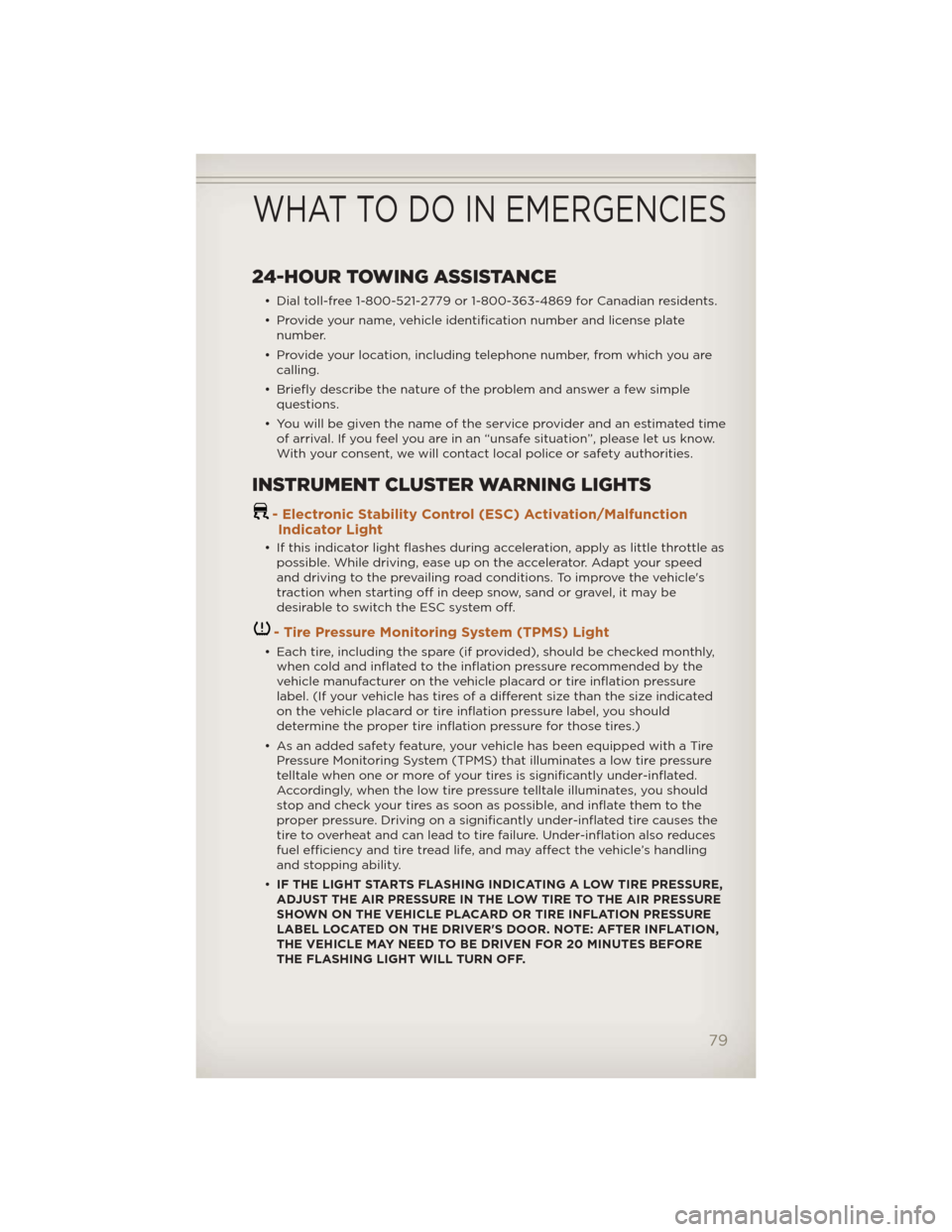
24-HOUR TOWING ASSISTANCE
• Dial toll-free 1-800-521-2779 or 1-800-363-4869 for Canadian residents.
• Provide your name, vehicle identification number and license platenumber.
• Provide your location, including telephone number, from which you are calling.
• Briefly describe the nature of the problem and answer a few simple questions.
• You will be given the name of the service provider and an estimated time of arrival. If you feel you are in an “unsafe situation”, please let us know.
With your consent, we will contact local police or safety authorities.
INSTRUMENT CLUSTER WARNING LIGHTS
- Electronic Stability Control (ESC) Activation/MalfunctionIndicator Light
• If this indicator light flashes during acceleration, apply as little throttle as
possible. While driving, ease up on the accelerator. Adapt your speed
and driving to the prevailing road conditions. To improve the vehicle's
traction when starting off in deep snow, sand or gravel, it may be
desirable to switch the ESC system off.
- Tire Pressure Monitoring System (TPMS) Light
• Each tire, including the spare (if provided), should be checked monthly,when cold and inflated to the inflation pressure recommended by the
vehicle manufacturer on the vehicle placard or tire inflation pressure
label. (If your vehicle has tires of a different size than the size indicated
on the vehicle placard or tire inflation pressure label, you should
determine the proper tire inflation pressure for those tires.)
• As an added safety feature, your vehicle has been equipped with a Tire Pressure Monitoring System (TPMS) that illuminates a low tire pressure
telltale when one or more of your tires is significantly under-inflated.
Accordingly, when the low tire pressure telltale illuminates, you should
stop and check your tires as soon as possible, and inflate them to the
proper pressure. Driving on a significantly under-inflated tire causes the
tire to overheat and can lead to tire failure. Under-inflation also reduces
fuel efficiency and tire tread life, and may affect the vehicle’s handling
and stopping ability.
• IF THE LIGHT STARTS FLASHING INDICATING A LOW TIRE PRESSURE,
ADJUST THE AIR PRESSURE IN THE LOW TIRE TO THE AIR PRESSURE
SHOWN ON THE VEHICLE PLACARD OR TIRE INFLATION PRESSURE
LABEL LOCATED ON THE DRIVER'S DOOR. NOTE: AFTER INFLATION,
THE VEHICLE MAY NEED TO BE DRIVEN FOR 20 MINUTES BEFORE
THE FLASHING LIGHT WILL TURN OFF.
WHAT TO DO IN EMERGENCIES
79
Page 82 of 124
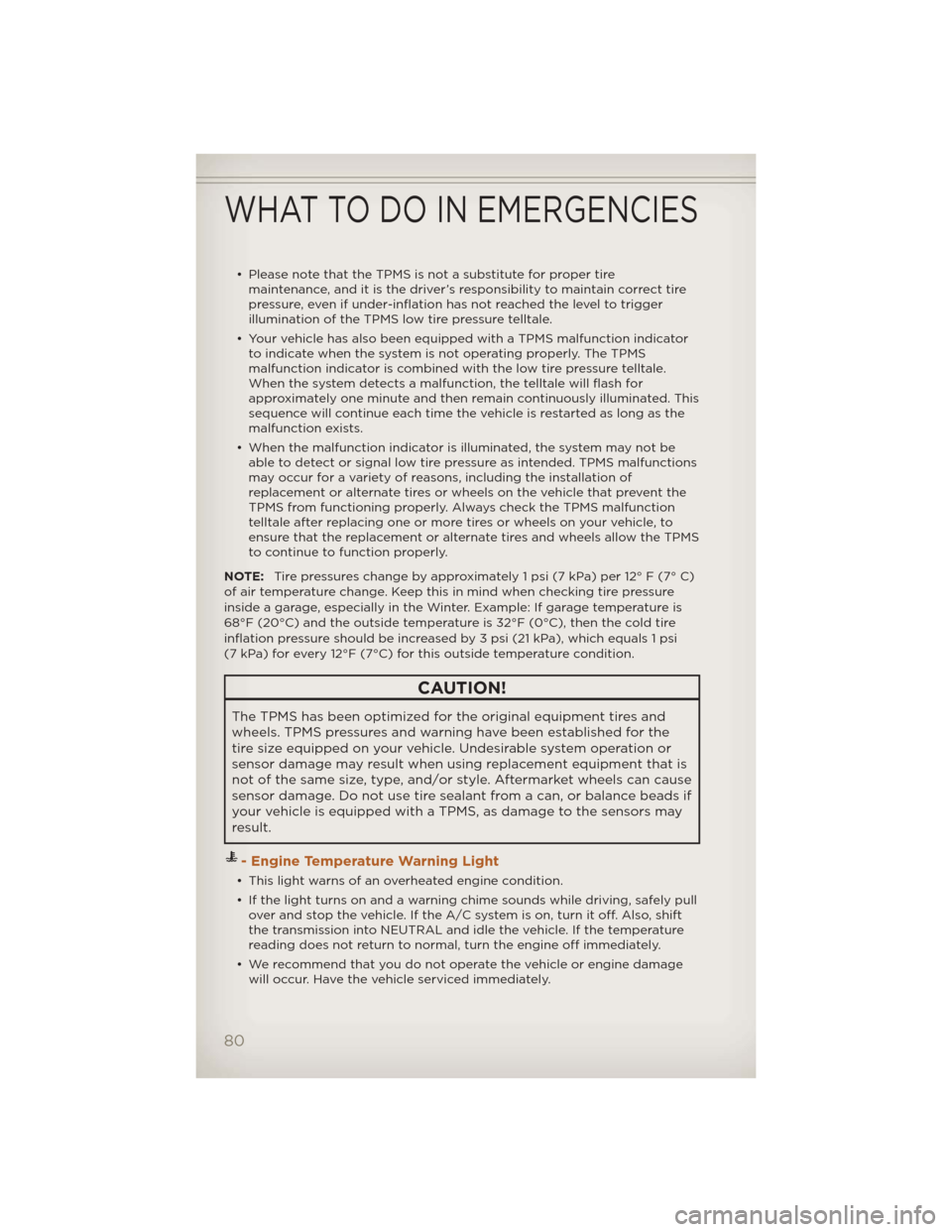
• Please note that the TPMS is not a substitute for proper tiremaintenance, and it is the driver’s responsibility to maintain correct tire
pressure, even if under-inflation has not reached the level to trigger
illumination of the TPMS low tire pressure telltale.
• Your vehicle has also been equipped with a TPMS malfunction indicator to indicate when the system is not operating properly. The TPMS
malfunction indicator is combined with the low tire pressure telltale.
When the system detects a malfunction, the telltale will flash for
approximately one minute and then remain continuously illuminated. This
sequence will continue each time the vehicle is restarted as long as the
malfunction exists.
• When the malfunction indicator is illuminated, the system may not be able to detect or signal low tire pressure as intended. TPMS malfunctions
may occur for a variety of reasons, including the installation of
replacement or alternate tires or wheels on the vehicle that prevent the
TPMS from functioning properly. Always check the TPMS malfunction
telltale after replacing one or more tires or wheels on your vehicle, to
ensure that the replacement or alternate tires and wheels allow the TPMS
to continue to function properly.
NOTE: Tire pressures change by approximately 1 psi (7 kPa) per 12° F (7° C)
of air temperature change. Keep this in mind when checking tire pressure
inside a garage, especially in the Winter. Example: If garage temperature is
68°F (20°C) and the outside temperature is 32°F (0°C), then the cold tire
inflation pressure should be increased by 3 psi (21 kPa), which equals 1 psi
(7 kPa) for every 12°F (7°C) for this outside temperature condition.
CAUTION!
The TPMS has been optimized for the original equipment tires and
wheels. TPMS pressures and warning have been established for the
tire size equipped on your vehicle. Undesirable system operation or
sensor damage may result when using replacement equipment that is
not of the same size, type, and/or style. Aftermarket wheels can cause
sensor damage. Do not use tire sealant from a can, or balance beads if
your vehicle is equipped with a TPMS, as damage to the sensors may
result.
- Engine Temperature Warning Light
• This light warns of an overheated engine condition.
• If the light turns on and a warning chime sounds while driving, safely pull over and stop the vehicle. If the A/C system is on, turn it off. Also, shift
the transmission into NEUTRAL and idle the vehicle. If the temperature
reading does not return to normal, turn the engine off immediately.
• We recommend that you do not operate the vehicle or engine damage will occur. Have the vehicle serviced immediately.
WHAT TO DO IN EMERGENCIES
80
Page 108 of 124
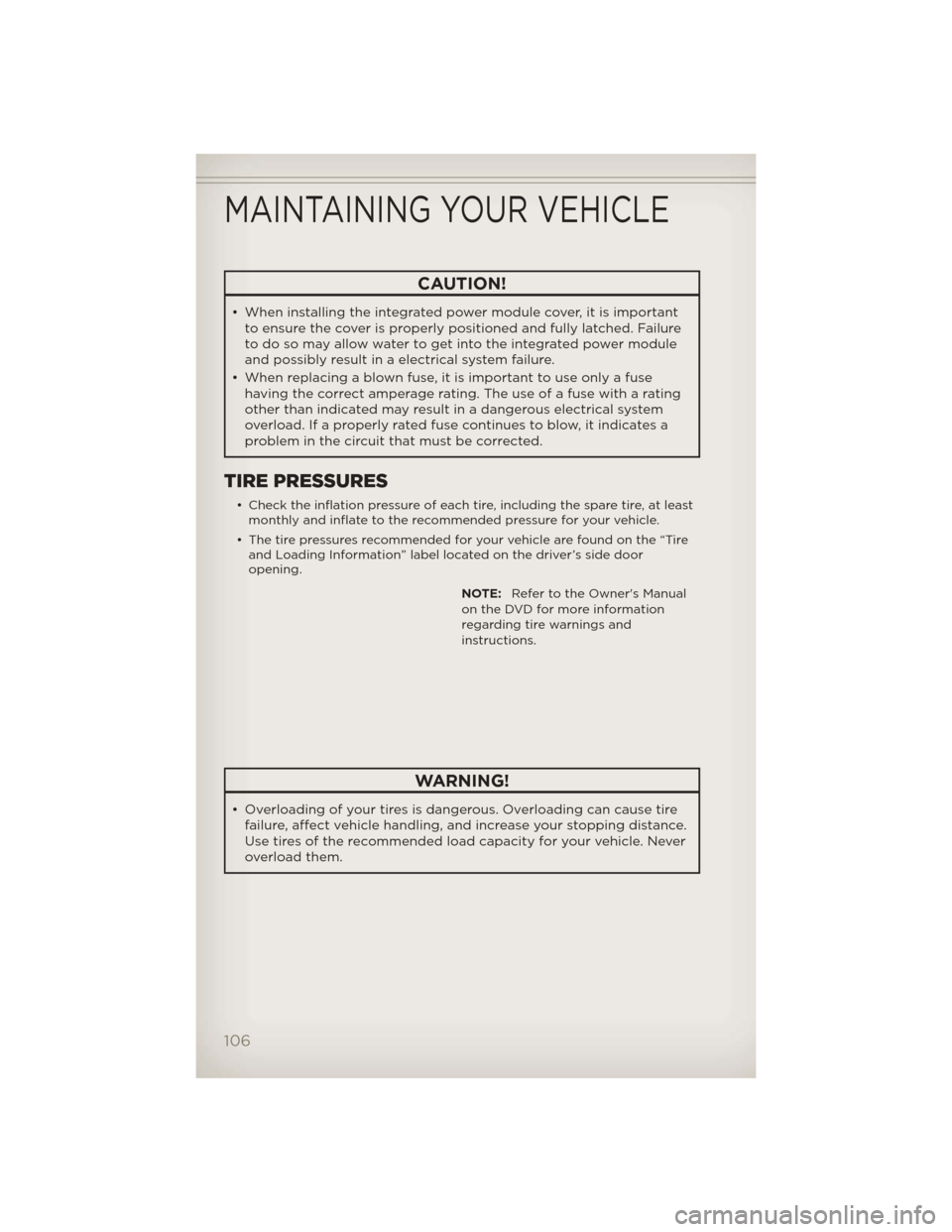
CAUTION!
• When installing the integrated power module cover, it is importantto ensure the cover is properly positioned and fully latched. Failure
to do so may allow water to get into the integrated power module
and possibly result in a electrical system failure.
• When replacing a blown fuse, it is important to use only a fuse having the correct amperage rating. The use of a fuse with a rating
other than indicated may result in a dangerous electrical system
overload. If a properly rated fuse continues to blow, it indicates a
problem in the circuit that must be corrected.
TIRE PRESSURES
• Check the inflation pressure of each tire, including the spare tire, at leastmonthly and inflate to the recommended pressure for your vehicle.
• The tire pressures recommended for your vehicle are found on the “Tire and Loading Information” label located on the driver’s side door
opening.
NOTE:Refer to the Owner's Manual
on the DVD for more information
regarding tire warnings and
instructions.
WARNING!
• Overloading of your tires is dangerous. Overloading can cause tire failure, affect vehicle handling, and increase your stopping distance.
Use tires of the recommended load capacity for your vehicle. Never
overload them.
MAINTAINING YOUR VEHICLE
106
Page 109 of 124
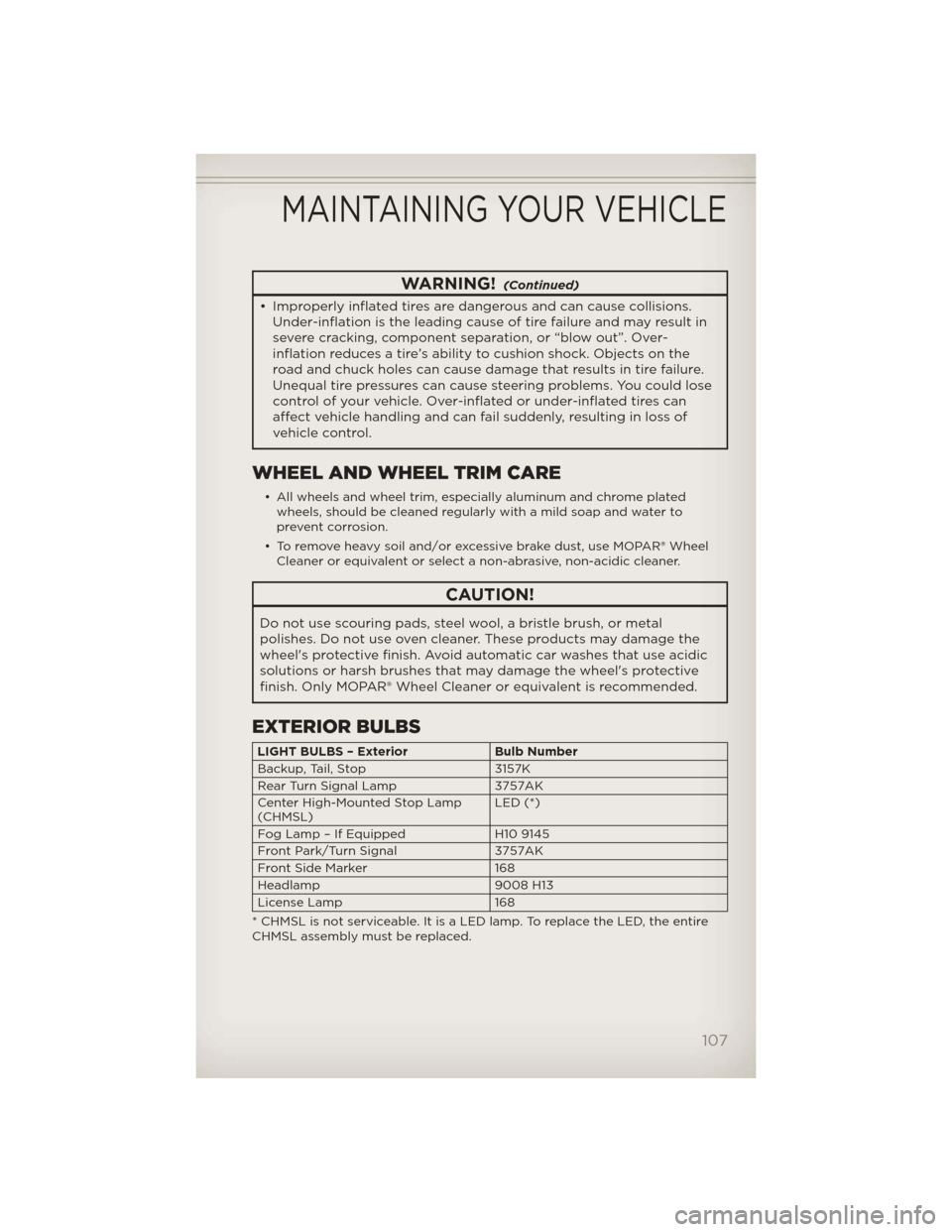
WARNING!(Continued)
• Improperly inflated tires are dangerous and can cause collisions.Under-inflation is the leading cause of tire failure and may result in
severe cracking, component separation, or “blow out”. Over-
inflation reduces a tire’s ability to cushion shock. Objects on the
road and chuck holes can cause damage that results in tire failure.
Unequal tire pressures can cause steering problems. You could lose
control of your vehicle. Over-inflated or under-inflated tires can
affect vehicle handling and can fail suddenly, resulting in loss of
vehicle control.
WHEEL AND WHEEL TRIM CARE
• All wheels and wheel trim, especially aluminum and chrome platedwheels, should be cleaned regularly with a mild soap and water to
prevent corrosion.
• To remove heavy soil and/or excessive brake dust, use MOPAR® Wheel Cleaner or equivalent or select a non-abrasive, non-acidic cleaner.
CAUTION!
Do not use scouring pads, steel wool, a bristle brush, or metal
polishes. Do not use oven cleaner. These products may damage the
wheel's protective finish. Avoid automatic car washes that use acidic
solutions or harsh brushes that may damage the wheel's protective
finish. Only MOPAR® Wheel Cleaner or equivalent is recommended.
EXTERIOR BULBS
LIGHT BULBS – Exterior Bulb Number
Backup, Tail, Stop 3157K
Rear Turn Signal Lamp 3757AK
Center High-Mounted Stop Lamp
(CHMSL) LED (*)
Fog Lamp – If Equipped H10 9145
Front Park/Turn Signal 3757AK
Front Side Marker 168
Headlamp 9008 H13
License Lamp 168
* CHMSL is not serviceable. It is a LED lamp. To replace the LED, the entire
CHMSL assembly must be replaced.
MAINTAINING YOUR VEHICLE
107
Page 113 of 124
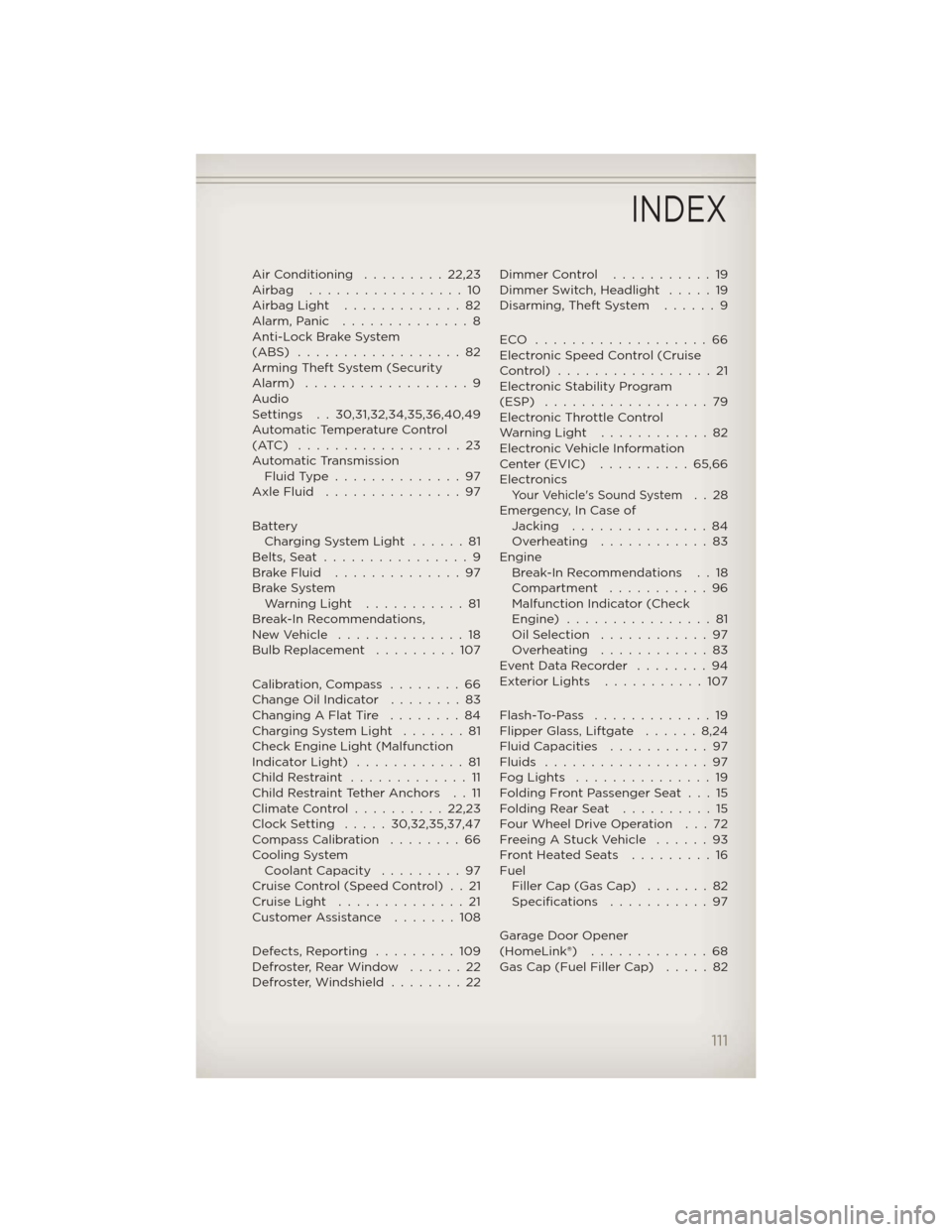
AirConditioning .........22,23
Airbag .................10
AirbagLight .............82
Alarm,Panic ..............8
Anti-Lock Brake System
(ABS)..................82
Arming Theft System (Security
Alarm) ..................9
Audio
Settings . . 30,31,32,34,35,36,40,49
Automatic Temperature Control
(ATC) ..................23
Automatic Transmission FluidType..............97
AxleFluid ...............97
Battery Charging System Light . . . . . . 81
Belts, Seat ................9
BrakeFluid ..............97
Brake System WarningLight ...........81
Break-In Recommendations,
NewVehicle ..............18
Bulb Replacement .........107
Calibration, Compass ........66
Change Oil Indicator ........83
Changing A Flat Tire . . ......84
Charging System Light . . . . . . . 81
Check Engine Light (Malfunction
IndicatorLight) ............81
ChildRestraint .............11
Child Restraint Tether Anchors . . 11
ClimateControl..........22,23
Clock Setting .....30,32,35,37,47
Compass Calibration . . . . . . . . 66
Cooling System Coolant Capacity .........97
Cruise Control (Speed Control) . . 21
CruiseLight ..............21
Customer Assistance . . . . . . . 108
Defects, Reporting .........109
Defroster, Rear Window . . . . . . 22
Defroster, Windshield . . . . . . . . 22 Dimmer Control . . . . . . . . . . . 19
Dimmer Switch, Headlight . . . . . 19
Disarming,TheftSystem ......9
ECO ...................66
Electronic Speed Control (Cruise
Control) .................21
Electronic Stability Program
(ESP) . . . . . .
............79
Electronic Throttle Control
WarningLight ............82
Electronic Vehicle Information
Center (EVIC) . . . . . . . . . . 65,66
Electronics
Your Vehicle's Sound System..28
Emergency, In Case of Jacking . . . . . . . . . . . . . . . 84
Overheating ............83
Engine Break-In Recommendations . . 18
Compartment . . . . . . . . . . . 96
Malfunction Indicator (Check
Engine) . . . . . . . . . . . . . . . . 81
OilSelection ............97
Overheating ............83
EventDataRecorder ........94
ExteriorLights ...........107
Flash-To-Pass .............19
Flipper Glass, Liftgate . . . . . . 8,24
Fluid Capacities . . . . . ......97
Fluids ..................97
FogLights ...............19
Folding Front Passenger Seat . . . 15
FoldingRearSeat ..........15
Four Wheel Drive Operation . . . 72
Freeing A Stuck Vehicle . . . . . . 93
Front Heated Seats . . . . . . . . . 16
Fuel Filler Cap (Gas Cap) . . . . . . . 82
Specifications . . . . . . . . . . . 97
Garage Door Opener
(HomeLink®) . . . . .........68
Gas Cap (Fuel Filler Cap) . . . . . 82
INDEX
111
Page 116 of 124
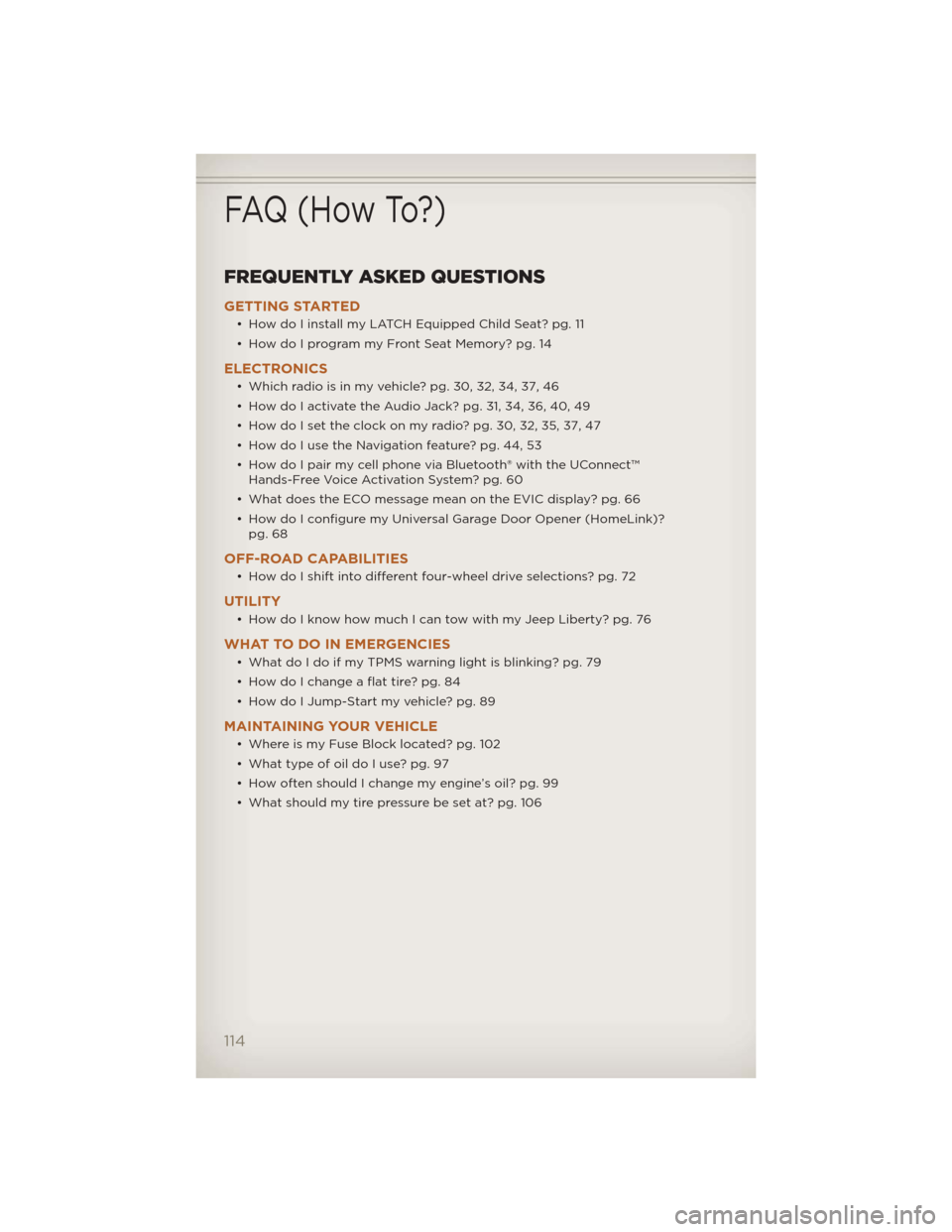
FREQUENTLY ASKED QUESTIONS
GETTING STARTED
• How do I install my LATCH Equipped Child Seat? pg. 11
• How do I program my Front Seat Memory? pg. 14
ELECTRONICS
• Which radio is in my vehicle? pg. 30, 32, 34, 37, 46
• How do I activate the Audio Jack? pg. 31, 34, 36, 40, 49
• How do I set the clock on my radio? pg. 30, 32, 35, 37, 47
• How do I use the Navigation feature? pg. 44, 53
• How do I pair my cell phone via Bluetooth® with the UConnect™Hands-Free Voice Activation System? pg. 60
• What does the ECO message mean on the EVIC display? pg. 66
• How do I configure my Universal Garage Door Opener (HomeLink)? pg. 68
OFF-ROAD CAPABILITIES
• How do I shift into different four-wheel drive selections? pg. 72
UTILITY
• How do I know how much I can tow with my Jeep Liberty? pg. 76
WHAT TO DO IN EMERGENCIES
• What do I do if my TPMS warning light is blinking? pg. 79
• How do I change a flat tire? pg. 84
• How do I Jump-Start my vehicle? pg. 89
MAINTAINING YOUR VEHICLE
• Where is my Fuse Block located? pg. 102
• What type of oil do I use? pg. 97
• How often should I change my engine’s oil? pg. 99
• What should my tire pressure be set at? pg. 106
FAQ (How To?)
114